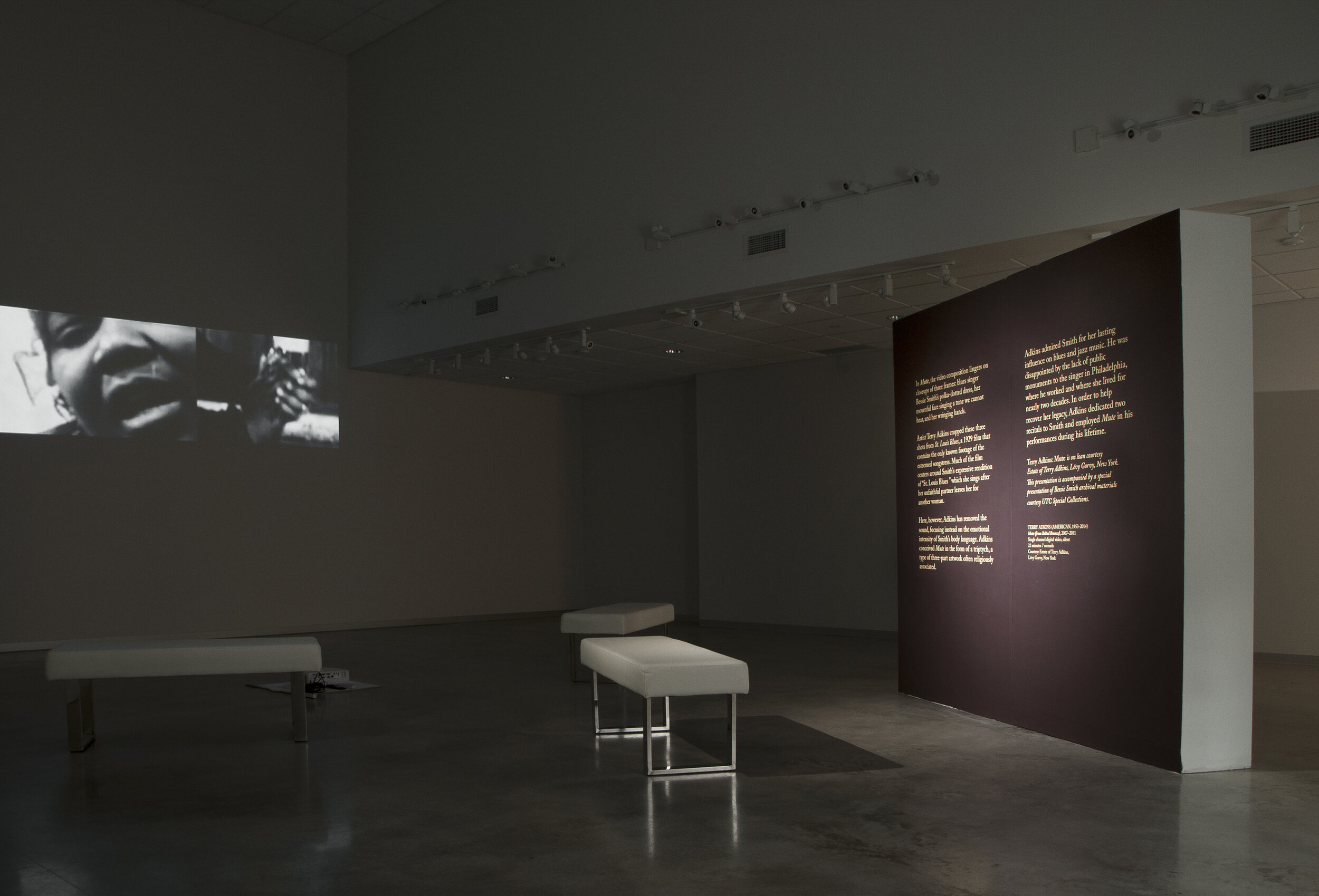Installation images: Terry Adkins: Mute, May 10-July 30, 2021, ICA at UTC. Photo: North Light Imaging.
Terry Adkins, Mute (from Belted Bronze), 2007 – 2011, single channel digital video, silent 22:07 minutes Edition of 5, with 1 AP, image: installation view Pulitzer Art Foundation, 2020. On loan courtesy The Estate of Terry Adkins, Lévy Gorvy, New York. Copyright Terry Adkins.
Terry Adkins: Mute
May 10-July 30, 2021
In Mute, the video composition lingers on closeups of three frames: blues singer Bessie Smith’s polka-dotted dress, her mournful face singing a tune we cannot hear, and her wringing hands.
Artist Terry Adkins cropped these three shots from St. Louis Blues, a 1929 film that contains the only known footage of the esteemed songstress. Much of the film centers around Smith’s expressive 1925 rendition of “St. Louis Blues,” which she sings after her unfaithful partner leaves her for another woman. Here, however, Adkins has removed the sound, focusing instead on the emotional intensity of Smith’s body language. Adkins conceived Mute in the form of a triptych, a type of three-part artwork often religiously associated.
Adkins admired Smith for her lasting influence on blues and jazz music. He was disappointed by the lack of public monuments to the singer in Philadelphia, where he worked and where she lived for nearly two decades. In order to help recover her legacy, Adkins dedicated two recitals to Smith and employed Mute in his performances during his lifetime.
Terry Adkins: Mute is on loan courtesy Estate of Terry Adkins, Lévy Gorvy, New York. Mute is accompanied by a special presentation of Bessie Smith archival materials courtesy UTC Special Collections.
About Terry Adkins:
Raised in a musical household, artist Terry Adkins (American, 1953–2014) made art that transgresses boundaries. Over more than three decades, he created an expansive and pioneering body of work that blends sculpture, sound, performance, video, and printmaking. Combining deep interests in history, language, and music, he devoted his work to upholding the legacies of larger-than-life figures, often from the canon of African American culture. Through his singular vision as well as his ongoing work as an educator and mentor, Adkins made a significant impact on the fields of contemporary sculpture and performance.
About Bessie Smith & “St. Louis Blues” (1925 song) (1929 film)
Bessie Smith (American, 1894-1937) was born in Chattanooga in 1894 and began performing on the streets at a very early age after the death of both parents. In 1912, Smith leaves Chattanooga to travel and perform in the Moses Stokes minstrel show, and soon thereafter in the Rabbit Foot Minstrels, of which blues vocalist Ma Rainey was a member. Rainey took Smith under her wing, and over the next decade, Smith continued to perform at various theaters and on the vaudeville circuit.
The popular American song “St. Louis Blues” was composed and published by W.C. Handy in 1914. Though accounts vary, Handy himself stated that he first encountered the song’s melody and some of the lyrics from a woman distressed over her absent husband in St. Louis, Missouri in 1892. Bessie Smith’s Columbia Records version from 1925 which features Louis Armstrong on the cornet, was recorded at the height of her music career while living in Philadelphia; it is the most popular version of this song ever recorded. By the end of the 1920s, Smith was the highest-paid Black performer of her day and had earned herself the title “Empress of the Blues.”
The film St. Louis Blues was directed by Dudley Murphy and produced by W.C. Handy in 1929 and features Bessie Smith and an all-African American cast; it is the only known film of Smith, and the soundtrack is her only recording not controlled by Columbia Records. Perhaps an antecedent to contemporary music videos, the film was considered a dramatization of the song.







